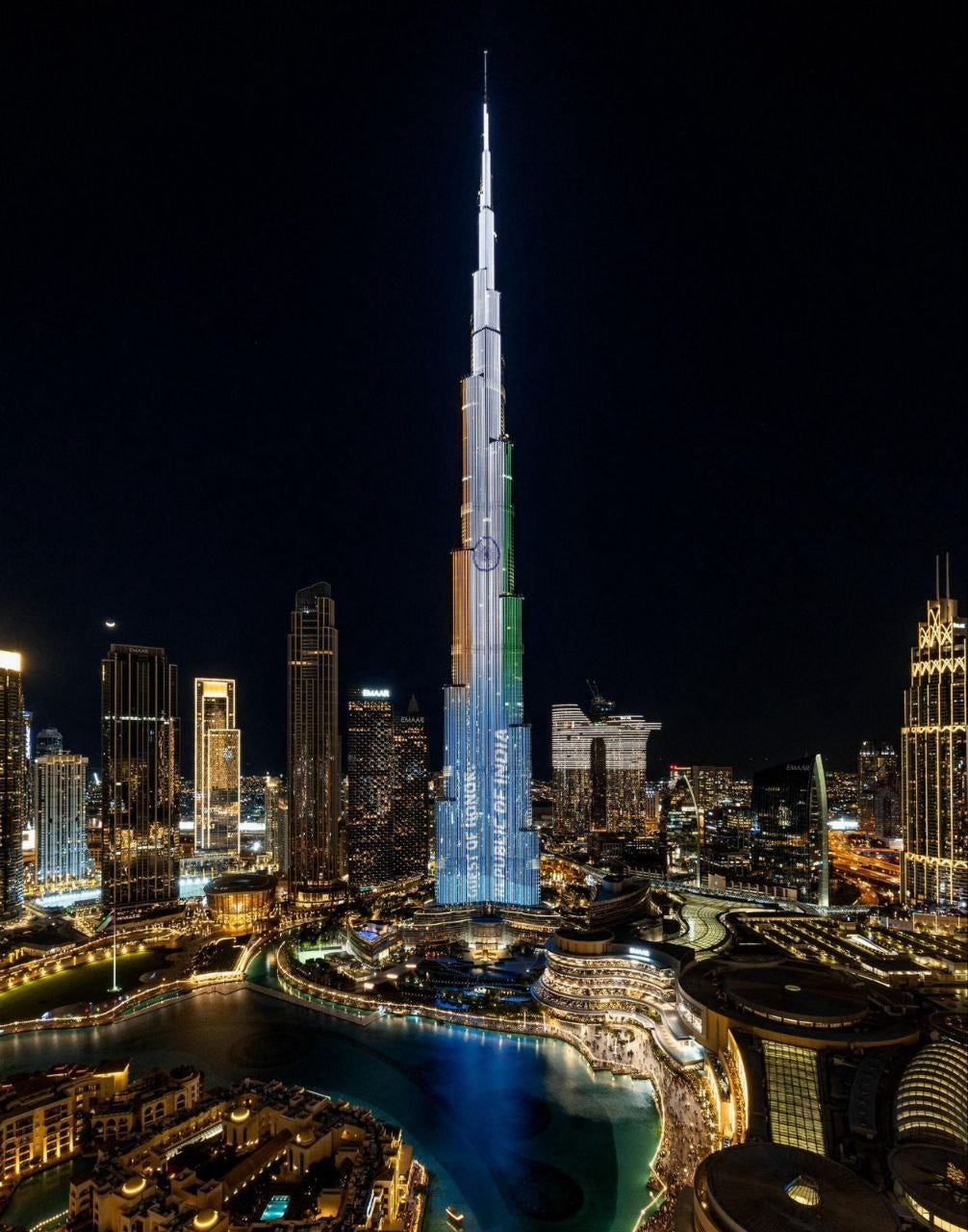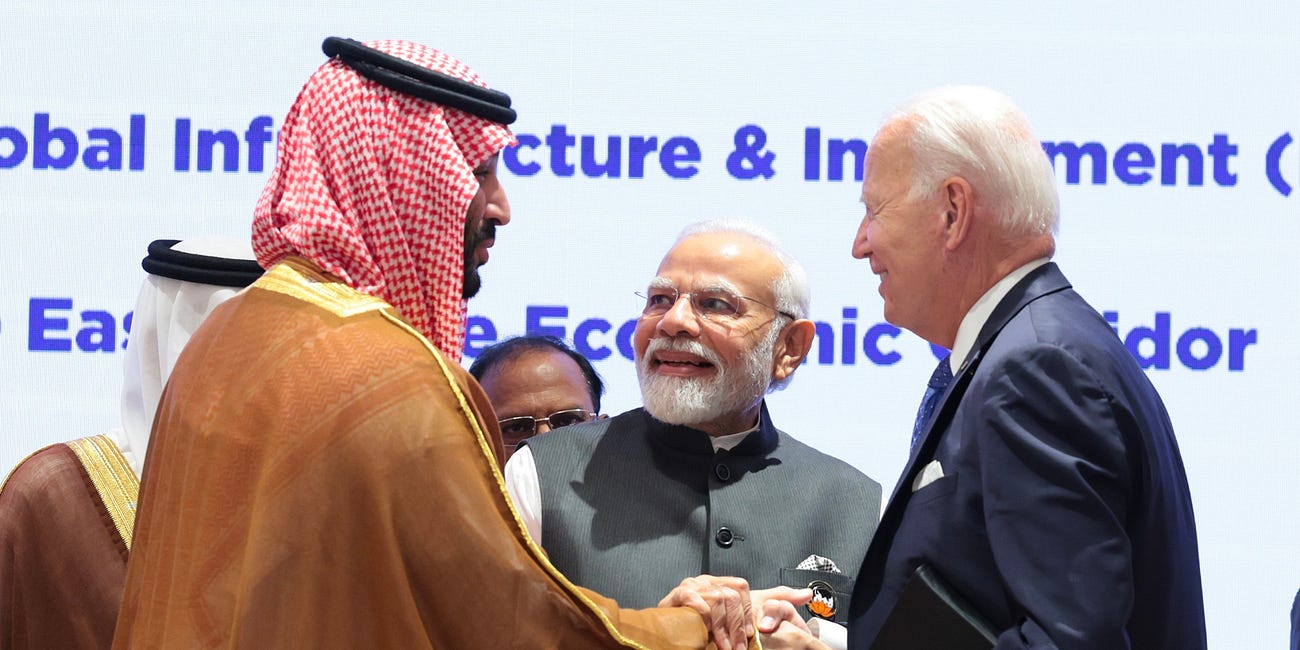Marhaba India!
UAE in particular and West Asia in general are partnering India to grow the influence of the Arabian Sea region in global polity. EPISODE #164
Dear Reader,
A very happy Monday to you.
Last week Prime Minister Narendra Modi landed in the United Arab Emirates (UAE)—his seventh visit in nine years—to renew ties between the two countries and forge new ambitions for the Arabian Sea region.
This is significant because West Asia, flush with petro-dollars, is among the few regions that have remained relatively unscathed by the unprecedented back-to-back economic shocks that began with the covid-19 pandemic. So, this week I explore this relationship. (Marhaba is the Arabic of welcome or a greeting.)
The cover picture is of the illuminated iconic Bhurj Khalifa and sourced from the Indian government.
A big shoutout to Surendra, Gautam, Premasundaran and Ranjini for your informed responses, kind appreciation and amplification of last week’s column. Once again, grateful for the conversation initiated by all you readers. Gratitude also to all those who responded on Twitter and Linkedin.
Unfortunately, Twitter has disabled amplification of Substack links—perils of social media monopolies operating in a walled garden framework. I would be grateful therefore if you could spread the word. Nothing to beat the word of mouth.
Reader participation and amplification is key to growing this newsletter community. And, many thanks to readers who hit the like button😊.
Ahlan Modi
Last week the Bhurj Khalifa, the iconic landmark in Dubai and supposedly the world’s tallest skyscraper, lit up with the Indian tricolour and the following message: Guest of Honour. Republic of India. Prime Minister Narendra Modi had just landed in the United Arab Emirates (UAE) for a state visit.
In its inimitable style, UAE was acknowledging its friendship with India and a leader who has gone out of his way to renew and deepen ties with their country. You would be surprised to note that when PM Modi landed in Abu Dhabi in 2015, a day after Independence Day, he was the first PM to do since 1981. Since Indira Gandhi’s visit in 1981, India diplomatically neglected the UAE for 34 years.
This is baffling. Given that the UAE is home to over 3.5 million Indian expats and that it is very important for India’s energy security.
Guess, better late than never. This was PM Modi’s seventh visit to the UAE—seven visits in nine years. And, the UAE, a country which values loyalty and led by HH Sheikh Mohamed bin Zayed Al Nahyan, reciprocated.
As a result, the relationship between the two countries has scaled unprecedented highs in the last decade.
The dramatic makeover of the relationship, included the inking of the Comprehensive Economic Partnership Agreement (CEPA) in 2022 and the multi-country India-Middle-East-Europe Economic Corridor (IMEEC) last September on the side-lines of the G20 summit meeting in New Delhi.
I was lucky to be commissioned by NRI Focus, an expat focused news platform based out of the UAE, to do a walk-up to Modi’s visit to the UAE. I chose to put the spotlight on the economics of the relationship. After all money talks.
And, then I happened to be in the country and eyewitnessed PM Modi’s two-day diplomatic blitz. This was the focus of the column I did for ndtv.com. I will dip into these contributions for this week’s newsletter.
Sharing the links to the walk-up published in NRI Focus and the wrap in ndtv.com. In case you wish to read them.
Ties That Bind
Historically, India and the UAE have enjoyed trade ties dating back centuries. In fact, at one time the India rupee used to be the currency for trade and transactions in the UAE.
This got a huge lift—making up for the over three decades of diplomatic neglect—with the signing of CEPA. At its core, the deal commits to enhancing bilateral trade between India and the UAE.
With a combined GDP of over $4 trillion, the two countries represent significant markets for each other’s goods and services. The CEPA blueprint envisages a progressive reduction in trade barriers, streamlining of customs procedures, and promoting greater market access to facilitate smoother trade.
Evidence suggests that this seems to be working. There is a visible spike in trade volumes after the signing of CEPA. To weed out the impact of the covid-19 pandemic, I compared the growth in trade volumes between 2019-20—the period just before the pandemic struck.
The growth in trade volume (exports together with imports) is dramatic. It grew by a staggering 43.6% (check out the graphic above).
This trend sustained with trade between the two countries in the first eight months of 2023-24 ended November (latest) estimated at $48.60 billion—compared to $59.12 billion for the full year in 2019-20.
A New Trade Corridor
The gains from CEPA can grow exponentially. Especially after the signing of the IMEEC—the multi-modal, inter-governmental infrastructure project connecting India to Europe—on the sidelines of the G20 summit last September.
Yes, the Israel-Hamas face-off has thrown a spanner in the works. But then the Houthi terror attacks on merchant ships using the Red Sea corridor to access the Suez Canal, has underlined the importance of an alternate route connecting South Asia to Europe through West Asia.
West bound trade from India will depart by sea and make land fall in Jebel Ali port in Dubai. From there, goods will be transported by freight train to Israel through Jordan. Thereafter they will be transported by ship to Europe.
Each partner country is a stakeholder and hence invested in servicing and protecting the supply chain. The IMEEC promised to be unlike anything the world had seen previously.
I had written about this in fair detail last year. Sharing the piece in case you want to read it.
The Train To Dubai
Dear Reader, A very Happy Monday to you. Little over a week ago, India, Saudi Arabia, United Arab Emirates, Jordan, Israel and the European Union inked an agreement for an economic corridor connecting India with Europe through the Middle East. This deal co-authored by the United States and India was clinched on the sidelines of the G20 summit meeting in N…
Not surprisingly, PM Modi’s latest visit formalised the deal.
Addressing the media, foreign secretary Vinay Mohan Kwatra, said:
“I would like to highlight the agreement on Intergovernmental Framework concerning cooperation on the IMEEC... This Agreement builds collaboration and also looks at specific things that the parties would do to promote cooperation in this space.
The main areas under this particular Agreement, which I have covered, are: One, relating to cooperation on logistics platforms, which is a crucial element of furthering the objectives of this particular Corridor.
Two, provision of supply chain services. Now supply chain services, not just limited to one or two things, but to cover all types of general cargo, bulk containers, and liquid bulk.”
And, then added in response to a question:
“The whole idea is that this economic corridor moves forward, strengthens regional connectivity, expands economic partnership, opens up new areas of opportunity for trade ties to grow, naturally.
It also opens up new opportunities for certain trade services to grow. So when you talk of logistics, naturally logistics services, besides the logistics infrastructure would be an important element of it.
All in all, a very important agreement for us.”
In the final analysis it is clear that the UAE has emerged as a very important partner for India. Not only is it key for India to expand its diplomatic footprint in a region key to its strategic interests, it is also now emerging as a gateway connecting Europe and Asia.
Yes, India may be off to a late start. But it is making up for lost time.
This converges with a growing interest of countries in West Asia to grow the influence of the long neglected Arabian Sea region in global polity. In this context too, the growing India-UAE relationship is a very important stepping stone.
Recommended Viewing/Reading
Sharing the latest post of Capital Calculus on StratNews Global.
A key omission in this year’s vote-on-account presented by Finance Minister Nirmala Sitharaman was disinvestment of government stakes in the public sector. Not since Finance Minister Yashwant Sinha formally included it in his aborted Budget for 1990-91 has disinvestment not figured in the annual presentation.
Is this then a paradigm shift? Is the government revisiting its disinvestment policy? To answer this and more I spoke to Tuhin Kanta Pandey, Secretary, Department of Investment and Public Management (DIPAM).
Sharing the link below. Do watch and share your thoughts.
Till we meet again next week, stay safe.





India continues to make the right moves and strengthening ties with the UAE , is of far reaching consequences. With Petroleum products as our largest import it is of critical importance to have a smooth relationship, especially in the context of a war looming in the Gulf region. Like Russia, this is another country where trade has happened in INR. The frequent visits by our charismatic PM, has definitely enhanced the acceptance of Indians working in UAE and Pakistanis are no longer the favored expatriates, due to religious reasons. Due to proximity and competitive prices, Indian goods and services are increasing their presence in the country. The growing influence of India, through the good offices of our PM, in the region, was demonstrated by the prompt release of 8 Indian navy veterans from Qatar. The efforts during the last 10 years, of this government has borne fruit. Thank you Anil for sharing this important article 🙏 👏
Hello Anil:
As always, a very timely, well-written column. I would only add that history is coming full circle as the disastrous effects of the Partition wear off. India has finally broken out of the straitjacket of the British-imposed post-Partition Subcontinental order, and is returning to its normal place in history in regard to its role in West Asia. Until now, Pakistan had played the role of Anglo-American-appointed security guarantor for the Gulf Arabs. That was the purpose for which Pakistan was created (Olaf Caroe wrote the book “Wells of Power” in the early 1950s). Of course, that model has collapsed. As a result, once again, India is at the heart of the Gulf’s present and future economic and security interests. In an earlier era, pre-Partition, you had Aden at one end, and Singapore at the other, with India sitting astride the Indian Ocean. Dubai is the new Aden. History has reasserted itself. And, you are there to chronicle the developments for us! Thank you.